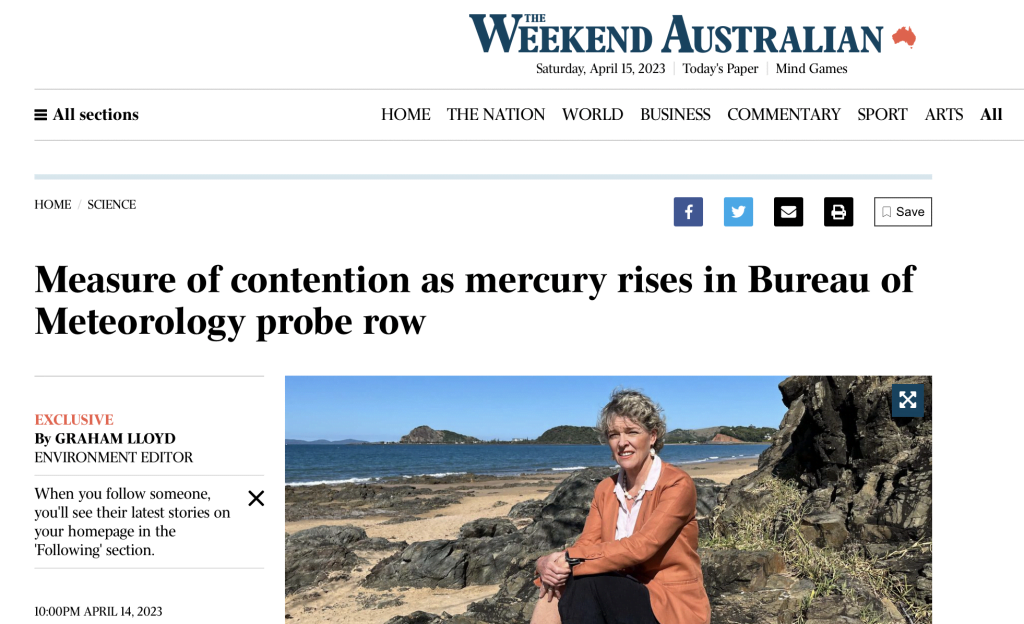The Australian Bureau of Meteorology has replaced most of its mercury thermometers with platinum resistance probes in automatic weather stations.
My assessment of nearly twenty years of parallel data from Mildura, and just three years of parallel data from Brisbane airport, indicates that the probes can record both hotter and colder than the mercury, but are not equivalent.
UPDATE
There was some discussion of the complexity of this issue, and I also chatted about the Great Barrier Reef, on TNT Radio with Chris Smith , his preamble and discussion with an economist precede my interview. To listen, click here:
https://tntradiolive.podbean.com/e/mike-shedlock-dr-jennifer-marohasy-on-the-chris-smith-show-19-april-2023/
Statisticians are notorious for disagreeing about the most appropriate statistical test to apply, but nevertheless should at the very least provide the name of the test undertaken and the level of significance, as a lawyer would detail the case law referenced.
The Bureau claims an assessment of the full 2019 to 2022 period for Brisbane Airport finds no statistically significant difference between the probe and mercury thermometer. But without providing any details.
More generally, their climate scientist, Blair Trewin, claims the parallel data –- temperature series recorded using a mercury thermometer and a platinum resistance probe at the same sites and at the same time –- are not significantly different across their network of some 700 automatic weather stations though as far as I can tell there is only parallel data for 38 sites.
My analysis of the three years of Brisbane Airport parallel data — only recently made available following years of wrangling over an FOI request with the Bureau — shows that 41% of the time the probe is recording hotter than the mercury, and 26% of the time cooler. The difference is statistically significant (paired t Test, n = 1094, p < 0.05).
The differences are not randomly distributed, and there is a distinct discontinuity after December 2019.
I initially thought that this step-change from an average monthly difference of minus 0.28 C in December 2019 to plus 0.11 in January 2020 (a difference of nearly 0.4C) represented recalibration of the probe.
The Bureau has denied this, explaining there was a fault in the automatic weather station that was immediately fixed and operating within specifications from January 2020 onwards. After January 2020, the probe can record up to 0.7C warmer.
I have been asking for all the parallel data to be made public, beginning with requests for data from Wilsons Promontory lighthouse back in 2015.
In 2011, an expert panel commented that throughout the last 100 years, Bureau ‘guidance’ has allowed for a tolerance of ±0.5 °C for field checks of either in-glass (mercury) or resistance thermometers (probes), and for this reason the Panel did not rate the observing practices of the Australian panel amongst international best practices.
It is time for another expert assessment, and for all the parallel data held by the Bureau to be made public. There should be 15 years in total of parallel data for Brisbane airport and a similar amount for another 37 of the Bureau’s 700 official weather stations.
I will be talking about these issues this afternoon on TNT radio with the legendary Chris Smith.
Wednesday, 19th April @ 2.30pm Australian Eastern Standard Time
Listen on the internet:
So far, the Bureau has claimed a variety of reasons for not making the parallel data public. In the case of the Brisbane airport data, it initially claimed that manually scanning the handwritten A8 report would be too onerous. When the FOI request by John Abbot ended up with the Information Commissioner the Bureau somewhat bizarrely claimed that the parallel data for Brisbane airport did not exist.
While providing me with nearly 10,000 scanned A8 reports for Mildura back in 2017 after the intervention of then Environment Minister Josh Frydenberg, the Bureau continues to withhold some key pages pertaining to September 2012.
I can only estimate likely differences between the probe and a mercury for the month of September at Mildura until this parallel data is made public. In the meantime, the Bureau stands by its claim that the temperature of 37.7C recorded by the probe at Mildura on 22rd September 2017 is a new hottest record back to 1889, even though temperatures were recorded with different equipment back then, with a mercury thermometer.




 Jennifer Marohasy BSc PhD is a critical thinker with expertise in the scientific method.
Jennifer Marohasy BSc PhD is a critical thinker with expertise in the scientific method.

It will only take a dubious annual increase of .05°c for the next 30 years to get to the dreaded +1.5°c.
BOM. We are all doomed!
Incredible deception by BOM. How can they claim any level of professionalism or ethics???
Bureaucratic institutions not making all data, statiscal methods and models readily available to the public is not in the public’s interest. So why do they withhold this information? This practice results in the public not trusting these institutions. It has gotten to the point that I do not believe anything from the government or their bureaucracy.
The fightback against spurious temperature data in America is being fought by the Heartland Institute which has just announced the following:
“Heartland’s recent research revealed that 96 percent of the National Oceanic and Atmospheric Administration’s (NOAA) temperature measurement stations are in locations that resulted in inaccurately high temperature readings.
In response, Heartland is launching our own private network of technologically superior temperature stations. They cost $2,000 per station, and every dollar you give will be matched dollar for dollar by one of our generous donors, who has pledged an uncapped matching challenge grant.”
This is great news and probably beyond Australians to do likewise but mighty oaks from little acorns grow so, maybe, one independent temperature station at a time is possible.
The dubious temperature readings reported by official government agencies are rapidly destroying any public trust in the temperature records. Public acceptance of the global warming narrative is fast disappearing to the extent that the message is now only being used by the eco-fanatics.